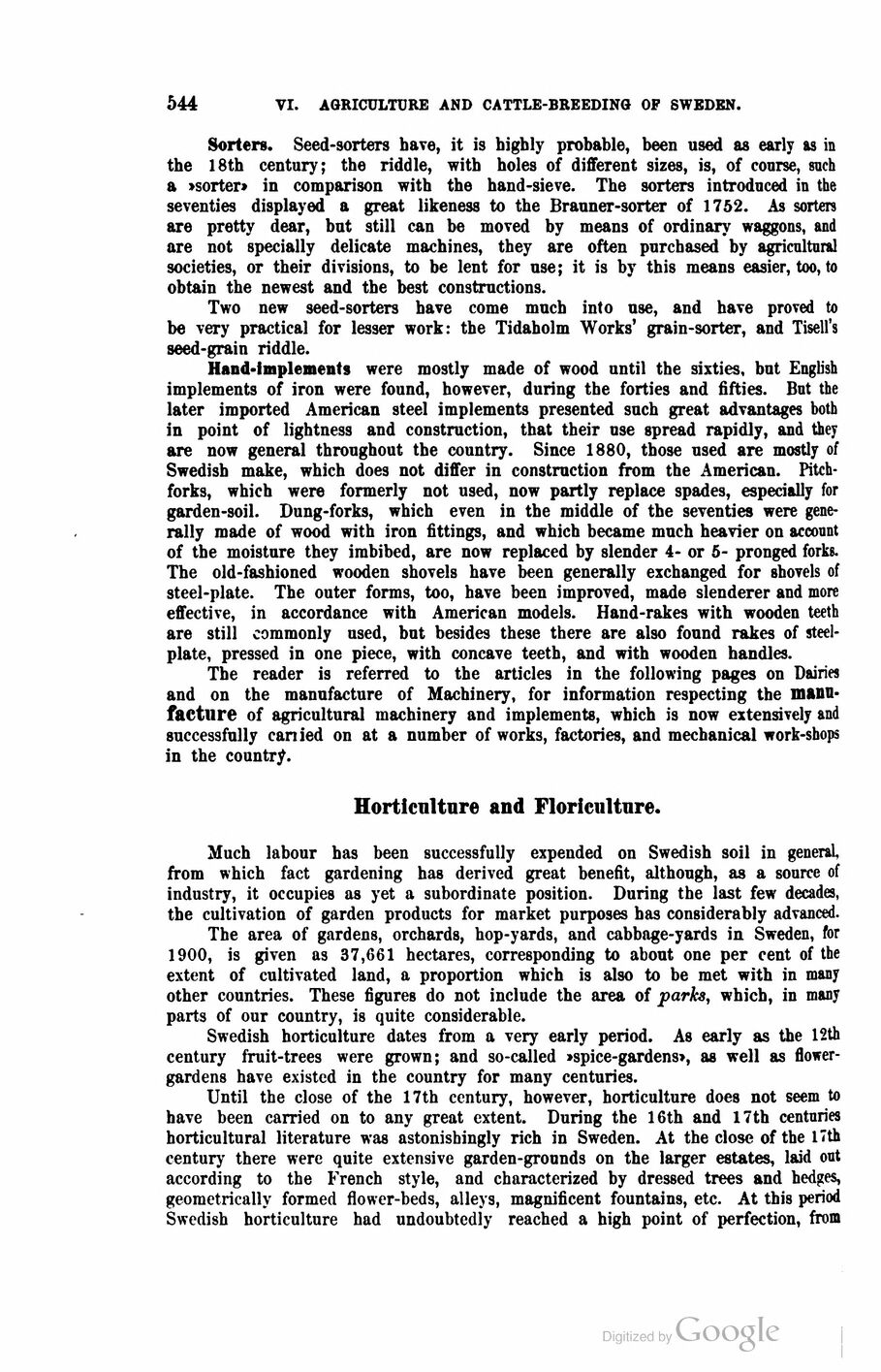
Full resolution (JPEG) - On this page / på denna sida - Second part - VI. Agriculture and Cattle-Breeding - 1. Agriculture. Partly after information from P. Lundell, Ebbetorp, Member of the Riksdag - Agricultural Machinery and Implements - Horticulture and Floriculture, after Director E. Lindgren, Tumba, and Director Aug. P. Andersson, Stockholm

<< prev. page << föreg. sida << >> nästa sida >> next page >>
Below is the raw OCR text
from the above scanned image.
Do you see an error? Proofread the page now!
Här nedan syns maskintolkade texten från faksimilbilden ovan.
Ser du något fel? Korrekturläs sidan nu!
This page has never been proofread. / Denna sida har aldrig korrekturlästs.
544
VI. AGRICULTURE AND CATTLE-BREEDING OF SWEDEN.
Sorters. Seed-sorters have, it is highly probable, been used as early as in
the 18th century; the riddle, with holes of different sizes, is, of course, such
a »sorter» in comparison with the hand-sieve. The sorters introduced in the
seventies displayed a great likeness to the Brauner-sorter of 1752. As sorters
are pretty dear, but still can be moved by means of ordinary waggons, and
are not specially delicate machines, they are often purchased by agricultural
societies, or their divisions, to be lent for use; it is by this means easier, too, to
obtain the newest and the best constructions.
Two new seed-sorters have come much into use, and have proved to
be very practical for lesser work: the Tidaholm Works’ grain-sorter, and Tisell’s
seed-grain riddle.
Hand-implements were mostly made of wood until the sixties, but English
implements of iron were found, however, during the forties and fifties. But the
later imported American steel implements presented such great advantages both
in point of lightness and construction, that their use spread rapidly, and they
are now general throughout the country. Since 1880, those used are mostly of
Swedish make, which does not differ in construction from the American.
Pitchforks, which were formerly not used, now partly replace spades, especially for
garden-soil. Dung-forks, which even in the middle of the seventies were
generally made of wood with iron fittings, and which became much heavier on account
of the moisture they imbibed, are now replaced by slender 4- or 5- pronged forks.
The old-fashioned wooden shovels have been generally exchanged for shovels of
steel-plate. The outer forms, too, have been improved, made slenderer and more
effective, in accordance with American models. Hand-rakes with wooden teeth
are still commonly used, but besides these there are also found rakes of
steel-plate, pressed in one piece, with concave teeth, and with wooden handles.
The reader is referred to the articles in the following pages on Dairies
and on the manufacture of Machinery, for information respecting the
manufacture of agricultural machinery and implements, which is now extensively and
successfully carried on at a number of works, factories, and mechanical work-shops
in the country.
Horticulture and Floriculture.
Much labour has been successfully expended on Swedish soil in general,
from which fact gardening has derived great benefit, although, as a source of
industry, it occupies as yet a subordinate position. During the last few decades,
the cultivation of garden products for market purposes has considerably advanced.
The area of gardens, orchards, hop-yards, and cabbage-yards in Sweden, for
1900, is given as 37,661 hectares, corresponding to about one per cent of the
extent of cultivated land, a proportion which is also to be met with in many
other countries. These figures do not include the area of parks, which, in many
parts of our country, is quite considerable.
Swedish horticulture dates from a very early period. As early as the 12th
century fruit-trees were grown; and so-called »spice-gardens», as well as
flower-gardens have existed in the country for many centuries.
Until the close of the 17th century, however, horticulture does not seem to
have been carried on to any great extent. During the 16th and 17th centuries
horticultural literature was astonishingly rich in Sweden. At the close of the 17th
century there were quite extensive garden-grounds on the larger estates, laid out
according to the French style, and characterized by dressed trees and hedges,
geometrically formed flower-beds, alleys, magnificent fountains, etc. At this period
Swedish horticulture had undoubtedly reached a high point of perfection, from
<< prev. page << föreg. sida << >> nästa sida >> next page >>